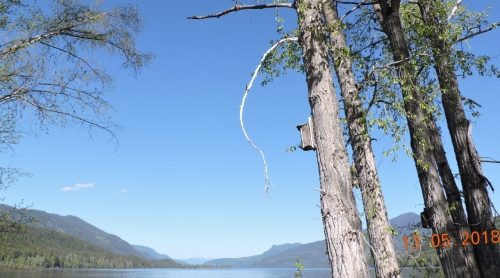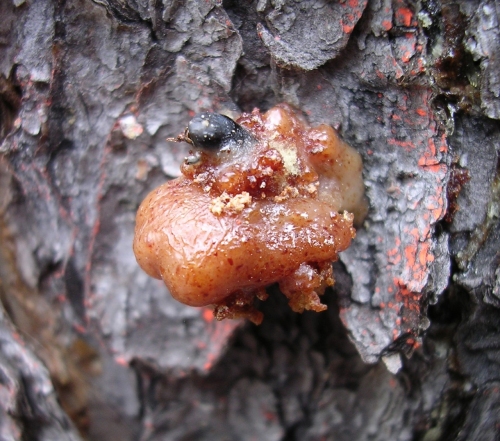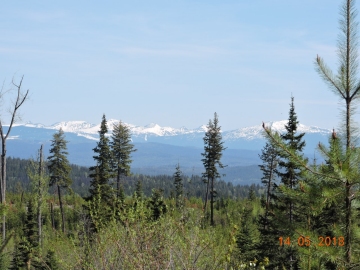by John Neville
We veered off the Green lake loop from Hwy 24 and our next stop was Mahood Lake at the western edge of Wells Grey Park. The route took us past Lone Bute(an ancient volcanic core) and a series of scenic lakes. The last 40 km are gravel and dry weather is recommended. The road took us over the Caribou range of the Columbia mountains, with the snow peaks of the Rockies off to the east. For those who like dramatic nature: Deception, Mahood and Canim Falls are nearby. After dark not one but two pairs of Barred owls visited the campsite. They appeared to be having a territorial dispute with appropriate hoots and caterwauling.
 Returning to Hwy 97 we picked up a few supplies in 100 Mile House. Just north of there we passed the first real evidence of the devastating fires of 2017. The land and tree trunks are still black. From there you can turn onto # 290 back country loop to explore through Forest Grove, Hendrix Falls, Bosk Lake, Crooked Lake and onto Black Creek road to Horsefly. Take the Ditch Road to Likely. The Likely Road returns you to 97. This is a very attractive loop with many lakes for fishing, canoeing, watching and listening to nature. The Info Center at 100 Mile can provide detailed maps and information. The marsh by the info center provides good birding and they have an extensive check list. Another attractive tour is available from the Likely Chamber of Commerce, which takes you along back roads through the Caribou Mountains from Likely to Barkerville.
Returning to Hwy 97 we picked up a few supplies in 100 Mile House. Just north of there we passed the first real evidence of the devastating fires of 2017. The land and tree trunks are still black. From there you can turn onto # 290 back country loop to explore through Forest Grove, Hendrix Falls, Bosk Lake, Crooked Lake and onto Black Creek road to Horsefly. Take the Ditch Road to Likely. The Likely Road returns you to 97. This is a very attractive loop with many lakes for fishing, canoeing, watching and listening to nature. The Info Center at 100 Mile can provide detailed maps and information. The marsh by the info center provides good birding and they have an extensive check list. Another attractive tour is available from the Likely Chamber of Commerce, which takes you along back roads through the Caribou Mountains from Likely to Barkerville.
We decided to head straight to Horsefly Provincial Park turning off 97 at 153 Mile House. The road parallels the Horsefly River and the Caribou Mountain peaks are off to the east. In 1859 the Horsefly River was the site of the first gold strike in the Caribou. Miners soon moved further north to places like Barkerville. At Horsefly DFO runs a Salmon spawning channel off the river. The returning fish can be seen in mid August for about 1 month. The females dig out nests in the gravel and competing males spread their milt over the eggs. The female chooses a nest site with just the right combination of clean gravel, adequate depth and good flow to provide oxygen to her eggs. The Salmon develop from eggs, to Alevins, to Fry, then Smolts and finally become mature in river estuaries. The salmon leave the spawning channel to reach the Fraser via Quesnel Lake, spend 1 to 7 years in the Pacific before returning to their home stream to breed and die.  The park was very quiet with campsites along Horsefly Lake. As it was a very hot day I tried a dip in the clear, cold water. A quick dip was enough, with a Spotted Sandpiper looking on. The warm evenings had allowed the bugs to mature. As I write Vireos, Warblers, Tanagers, Flycatchers and Swallows were all enjoying the insects.
Mountain Pine Beetle occur naturally in Lodgepole, Ponderosa, and White-bark Pine. Because our winters have recently become milder, the beetles are no longer killed off and have reached epidemic proportions in some areas like the Caribou. As trees die, the needles turn red, then fall off. The dead trees become grey in colour. The adult beetles bore into the trees in mid summer and lay eggs in galleries. They carry a fungus which causes dehydration and inhibits the trees natural defenses against further beetle attacks. The eggs hatch in a few weeks and the larvae begin mining out from the galleries, girdling and killing the tree. The following summer the newly mature beetles bore out of the bark and fly to new trees starting the cycle over again (see picture). Trees react by exuding pitch through the bore holes. This can be seen as blisters on the dead trunks.
The park was very quiet with campsites along Horsefly Lake. As it was a very hot day I tried a dip in the clear, cold water. A quick dip was enough, with a Spotted Sandpiper looking on. The warm evenings had allowed the bugs to mature. As I write Vireos, Warblers, Tanagers, Flycatchers and Swallows were all enjoying the insects.
Mountain Pine Beetle occur naturally in Lodgepole, Ponderosa, and White-bark Pine. Because our winters have recently become milder, the beetles are no longer killed off and have reached epidemic proportions in some areas like the Caribou. As trees die, the needles turn red, then fall off. The dead trees become grey in colour. The adult beetles bore into the trees in mid summer and lay eggs in galleries. They carry a fungus which causes dehydration and inhibits the trees natural defenses against further beetle attacks. The eggs hatch in a few weeks and the larvae begin mining out from the galleries, girdling and killing the tree. The following summer the newly mature beetles bore out of the bark and fly to new trees starting the cycle over again (see picture). Trees react by exuding pitch through the bore holes. This can be seen as blisters on the dead trunks.
Back on Hwy 97 we stopped at Scout Island to see the amazing work of the Williams Lake Field Naturalists. They have repaired a damaged wetland within the city limits and created attractive trailsand a nature house for residents and visitors alike. We hope you will join us again in the next issue of the BC Nature magazine when we travel from Prince George to the Alaska Highway.  
|